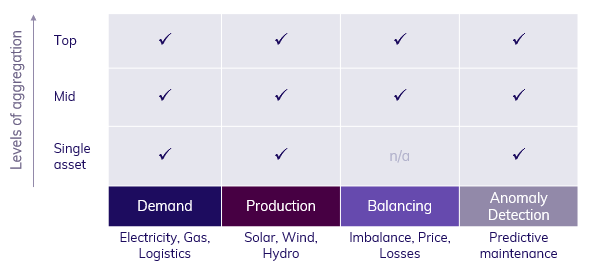Business Benefits
One unified solution
The core of TIM is designed for generic time series forecasting. TIM covers most of the subdomains of the utilities industry, such as the prediction of electricity load, gas consumption, district heating and cooling, solar production, wind production and price forecasting.
Traditionally, specialized solutions and models were developed to address each of these diverse forecasting challenges. Within one company there are often several different solutions in use, coming from different vendors, to cover different forecasting needs. TIM permits users to unify this framework of different solutions by providing one umbrella solution that covers all of these needs.

In time, TIM will be expanded to cover an even more diverse set of domains, going beyond the utilities industry into other exciting fields, such as finance and retail.
Maintaining an overview
Even when considering one single quantity, it is often necessary to develop several models for different prediction horizons and different data availability situations. Consider this: the electricity load of a major city needs to be forecasted every day at 10:00 and at 15:00. At each of these times, several forecasts are desired: specifically an intra-day forecast (D), a day-ahead forecast (D+1), a D+2 forecast, a D+3 forecast, a D+7 forecast and a month-ahead forecast.
Traditionally, for each of the prediction horizons an individual model is created (i.e. six different models) for both the situation at 10:00 and the situation at 15:00. This results 12 different models (6 horizons for 2 data availability situations). It is easy to see how this could quickly result in a chaotic and confusing ensemble of models. It is vital for a company’s efficiency to maintain an overview of all different available models and to define a clear system deciding which models is most appropriate in which situation(s).
TIM has a multi-situational multi-point layer that addresses this challenge by creating a Model Zoo. This Model Zoo consists of all the necessary models from which TIM can dispatch the appropriate model for each specific forecast. In doing so, TIM takes over the responsibility from the user and presents the user with a straightforward way to work with a variety of different forecasting models.
Forecasting and Anomaly Detection in one API
Forecasting and anomaly detection have traditionally been viewed as two completely different application areas. Many software solutions therefore address either forecasting or anomaly detection and combination of the two is rare. From a mathematical point of view, however, forecasting and anomaly detection have many aspects in common. Forecasting is about knowing what value is expected; anomaly detection adds on this knowledge by comparing the expected value to the actual value. TIM leverages this fact and provides both functionalities in one single solution via a single API.
Data Science Exploration tool
TIM is designed to quickly identify relevant features in data. This is also the most important quality of efficient data science exploration tools. Therefore, TIM can easily be used for data science exploration. In many situations, adding a relevant feature results in an enormous increase in performance, which indicates the importance of data exploration. In this aspect TIM again rises above AutoML approaches, where results ‘only’ indicate which modelling technique and which hyperparameters perform best out of all the tested scenarios.